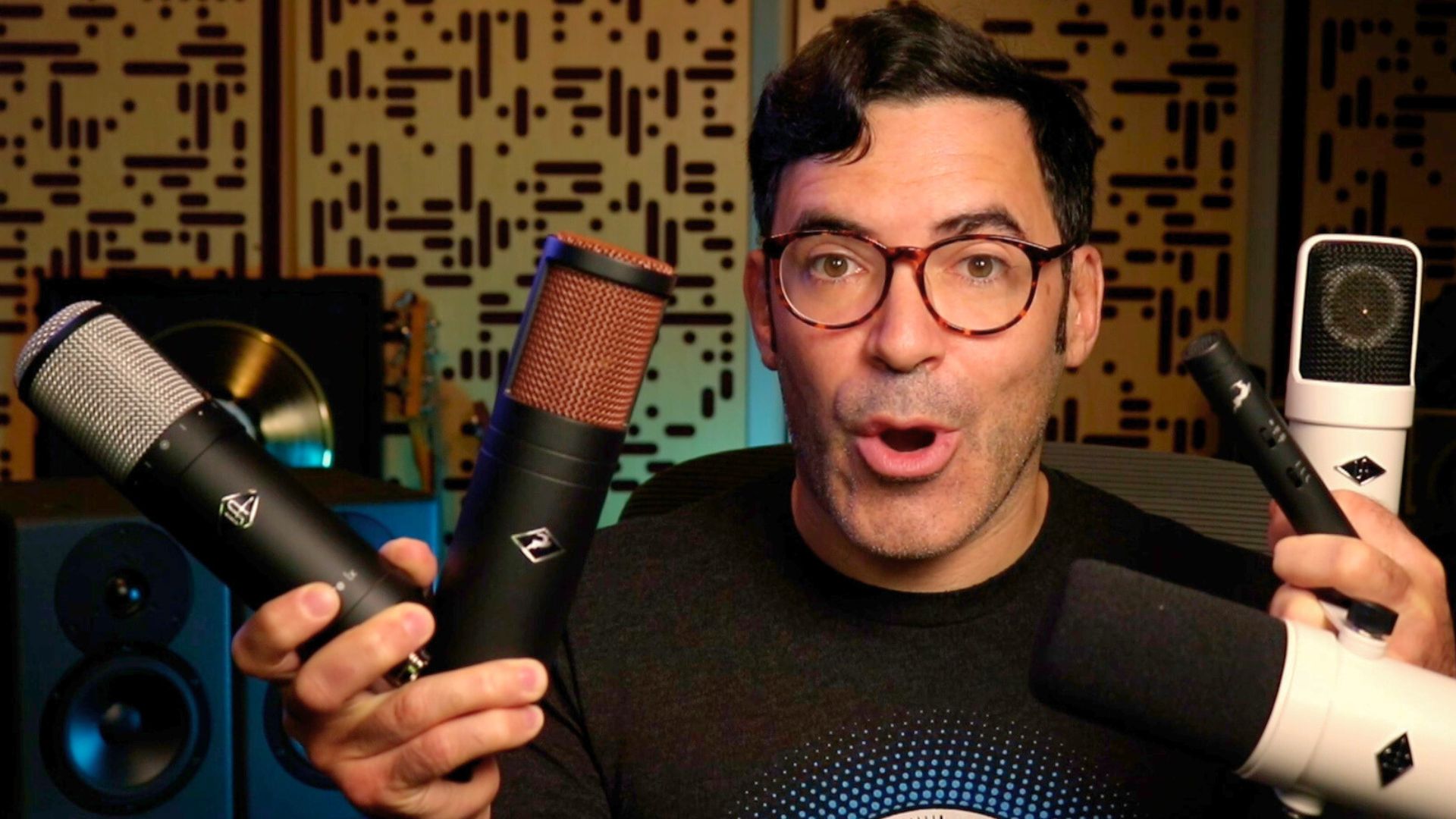What is the Best Modeling Mic? Top Models Compared (UAD, Antelope, Slate)

Introduction: What is the Best Modeling Mic for You?
What is the best modeling mic on the market? I gathered together more than a half dozen modeling microphones in my studio (and auditioned some more outside the studio), all to help answer that question.
Currently, there are three major players in this field: Universal Audio (UAD), Antelope Audio, and Slate Digital. All three companies offer a variety of modeling mics for different purposes, with prices from about $120 all the way up to $2500.
So what option is best for you?
I’ll give you a complete breakdown, but before I do, a few notes on whether modeling microphones are even worth it at all!
The Real History of Modeling Microphones
Modeling mics have come a LONG way since I first became familiar with the concept way back in 2000, when Antares released their original “Mic Mod” plugin.
The concept was cute, and the tool was potentially useful. This little plugin had a database of frequency responses for a variety of different popular microphones.
All you had to do was select your source microphone and your desired output microphone, and the frequency curve would automatically adjust to emulate the sound of just about any major mic.
The idea was ahead of its time, it was very easy to use, and could actually offer some real benefits in transforming the tone of sources when they just didn’t feel right in the mix as recorded.
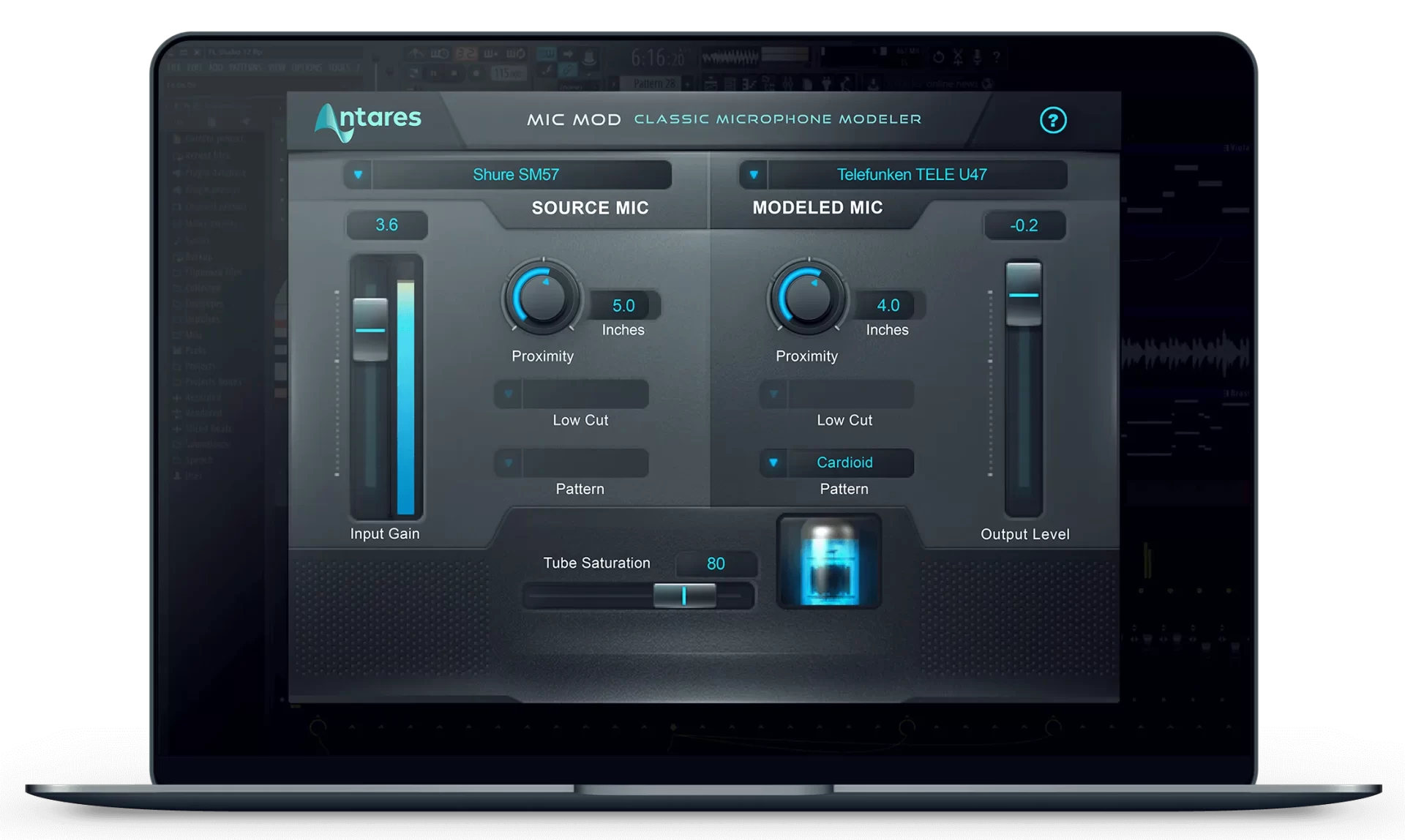
Antares Mic Mod was an early attempt at mic modeling, that is still available today—with an updated GUI.
Buy it new on Sweetwater, B&H, Thomann, or Amazon. Look for deals on Reverb.
This early stab at mic modeling is still worth trying out given the low price of the plugin, but to those of us who were experienced with high end and vintage microphones, it wasn’t always exactly persuasive or authentic.
Fast forward 20-some years and the landscape has completely changed. Beginning in 2014 when Slate announced their Virtual Microphone System, modeling mics became a truly viable option for the studio. And they’ve only improved since.
In 2016, Townsend Labs introduced the Sphere L22 microphone, which added an additional capsule, along with dual outputs, to even more accurately model classic mics and their polar patterns and off axis frequency response. Antelope Audio quickly followed suit with their first Edge microphones in 2017.
Since Universal Audio bought Townsend Labs in 2021, they’ve only made their products better, more affordable and more diverse. Since then, each have tried to outdo the other, with Antelope and Slate releasing products that push the boundaries of price and features, and UA firing right back at them.
Today, modeling mics are good enough to be used on major commercial recordings—including numerous giant pop hits that have been streamed hundreds of millions of times or more.
They’ve also come down remarkably in price, with incredibly inexpensive options now available from all three major brands, as well as high quality models around $1000 and up that could potentially be the only mic some small studios will ever need.
There are also now dynamic options as low as $109, as well as small condensers as low as $149, that could be suitable for many studios.
On the software-only front, IK Multimedia have developed their own inexpensive plugin similar to the old Antares Mic Mod, which they call Mic Room. Like its predecessor, Mic Room is a remarkably affordable plugin that can turn practically any microphone into a modeling mic of sorts.
But there are some real advantages to using dedicated hardware modeling mics, which generally have much more accurate performance. This is especially the case for dual-output modeling mics like those made by Universal Audio and Antelope Audio in their Sphere and Edge series.
Pros and Cons of Modeling Microphones
There are endless “pros” to modeling mics:
First, there’s the ability to emulate the sound of countless high end, vintage and boutique at a fraction of the price, often with shocking accuracy and incredible sound quality. For a price close to $1000, you can persuasively emulate numerous mics that cost thousands or even tens of thousands more.
But it doesn’t end there: Producers and engineers have the option to switch through mic models after the singer has done their take, so there’s no waiting around, wearing out or boring the artist as you audition different microphones to get the “perfect” sound.
There’s also the ability to have a whole locker full of mics that suit different voices and instruments without having to buy and maintain dozens of mics, or feeling obligated to learn them all.
With some of the multi-capsule versions, you can even change polar patterns or mic placement after the fact!
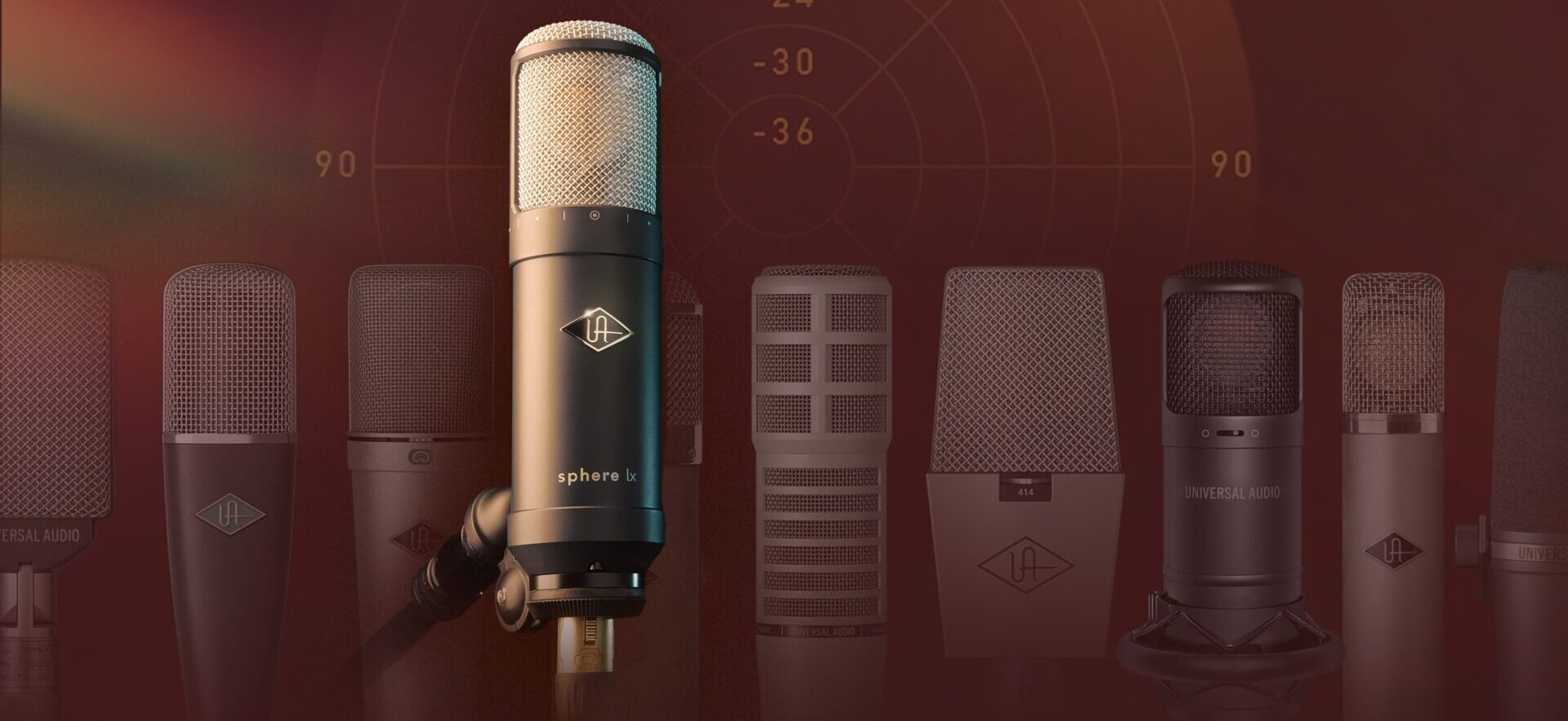
Modeling mics, like this Universal Audio Sphere LX, give you an entire library of history’s best mics for one low price.
Buy it new on Sweetwater, B&H, Thomann, or Amazon. Look for deals on Reverb.
But there are also some “cons”:
Some users feel can overwhelmed by the sheer number of choices, and end up selling their modeling mics due to “option paralysis”.
This is potentially the biggest negative of modeling mics: To some, they offer “too much of a good thing”.
They can lead to a workflow that feels beset with endless choices, that could take producers and artists out of the music and into a technical frame of mind… or keep them obsessed with the minutia of making records, instead of focused on the big picture choices that really make a difference.
Because of this, modeling mics aren’t always the best option for singers and songwriters who are recording themselves.
Those self-recording artists who aren’t as technically interested may find the choices overwhelming, mind boggling, and sometimes too minor or too massive to be useful.
On the other hand, those self-recording artists who are interested in mics and technology may find themselves spending too much time fiddling with microphone choices instead of focusing on what really matters: Writing great music and getting great takes!
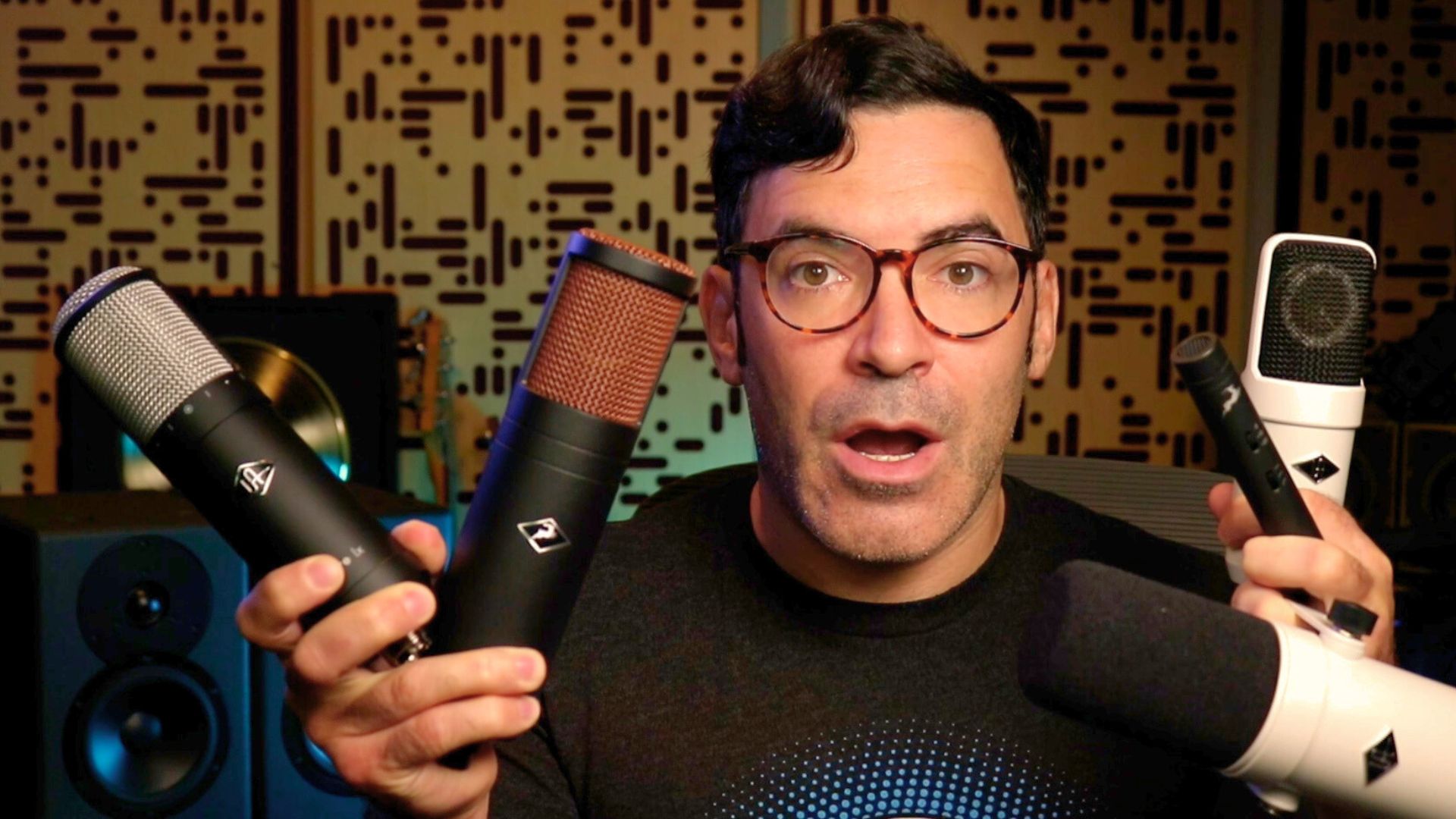
One potential drawback of modeling mics is that they can leave you flabbergasted by all the possible choices.
To counteract this, if you do choose a modeling mic, it’s wise to do an initial deep exploration period where you play around and get to learn the feel of some of these great mics from recording history, and then narrow down your options to just a few choices that you love the sound of for specific applications. Choices that you will come back to again and again without testing each time.
Another con is that modeling mics require software to unlock the modeled sounds, and so aren’t suitable for analog-only live environments, or studios without a computer. But this is less and less of an issue in the modern era. (And theoretically, you could even record with these mics without a computer, and then add the plugin after the fact with no ill effect.)
The only other substantial issue is that aesthetically, modeling mics may not always be as inspiring for the performer as classic, vintage or boutique microphones that may have a distinct visual appeal—and a potentially meaningful story behind them.
One could argue that another con is that some of these mics perform at their best when coupled with specific hardware interfaces made by the brand that makes the microphones.
While that is true, just about all these mics are priced so that they still make sense even if you use some other brand’s interfaces and miss out on some of the unique options and tools available with the same brand’s hardware.
As of 2024, I cannot say that price is substantial “con” when it comes to modeling mics any longer. Prices are now so affordable, with options running as cheap as $100, that in the future, it’s likely that just about every serious studio may have at least one modeling mic.
Which Brand is Best? UAD vs Antelope vs Slate, RANKED
All three of the major brands on the market make great modeling mics, and there is no question that you can make great sounding recordings with ANY of the options we’ll cover today.
In fact, major hit releases HAVE been made already with all three of these modeling mic systems, so you don’t have to worry about them holding you back. With that said, each brand has a bit of its own personality, and its own strengths and weaknesses.
My following assessment of each is informed by my own personal tastes and biases, and your tastes, experience and biases may be different. Don’t be ashamed or surprised if your own picks and ranking may be slightly different than mine.
So, how do they stack up in my view?
Universal Audio—Winner: Best All-Around
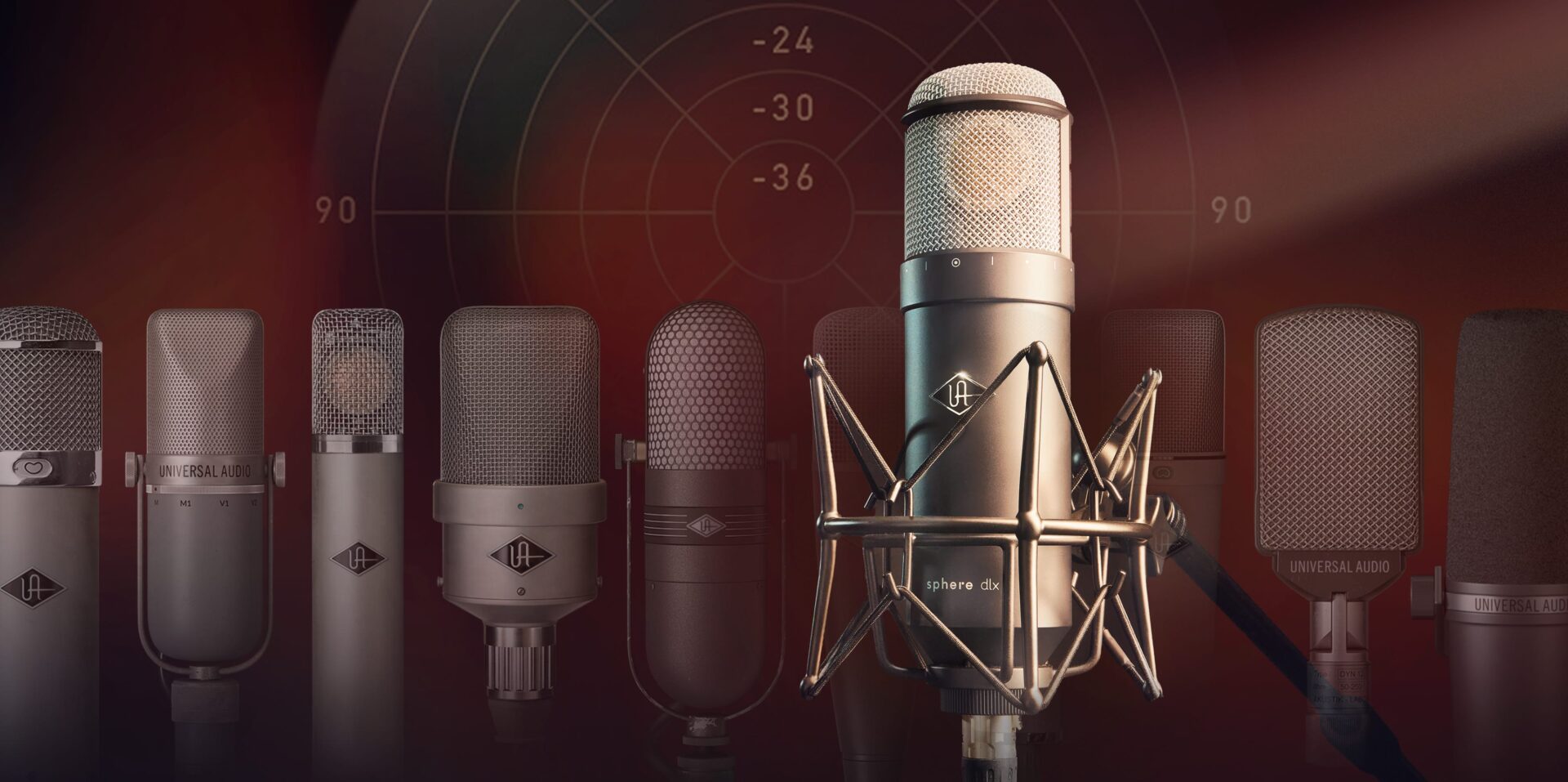
The Universal Audio Sphere DLX
Buy it new on Sweetwater, B&H, Thomann, or Amazon. Look for deals on Reverb.
Top Picks:
Sphere LX: $999
Sphere DLX: $1499
Other Options:
Standard SC-1: Large Condenser (Single Capsule): $399
Standard SP-1: Small Condenser pair: $399 (On sale for $349!)
Standard SD-1: Large Dynamic Mic: $249
Standard SD-5: Dynamic Kick Drum Mic: $179
SD-7: Dynamic Tom/Instrument Mic: $129
SD-3: Dynamic Snare/Instrument Mic: $109
After extensive testing, for my personal tastes, I’d put Universal Audio as my top pick for the brand that is “Best All Around”.
In my opinion, their hardware-accelerated Sphere series have the best GUIs, user experience and feature sets of the three major brands. They also work nicely without UAD hardware.
But that doesn’t mean UA are my top recommendation for everyone. At certain price points, and for certain use cases, there are reasons you might pick either of the other major brands over UA for your own studio. More on that in a minute.
Universal Audio also win out just slightly for me when it comes to sound quality. But the differences on that front were not large at all, and sometimes there wasn’t very much of a difference at all.
Comparing the sound of the Sphere series to comparable mics from Slate and Antelope, in my own tests (and the tests I could find from others online), there were cases where I found UA’s models to sound closest to the modeled mic, or to my memory of the sound of the original types of mics that were emulated… when a meaningful difference could be heard at all.
In those cases where there was a notable difference, UAD generally skewed toward a slightly fuller and potentially more “authentic” sound than some of the other brands’ models, when comparing similar options.
It’s worth noting again however, that the sound differences between brands were usually very minor, and in many cases, could be basically nonexistent for practical purposes.
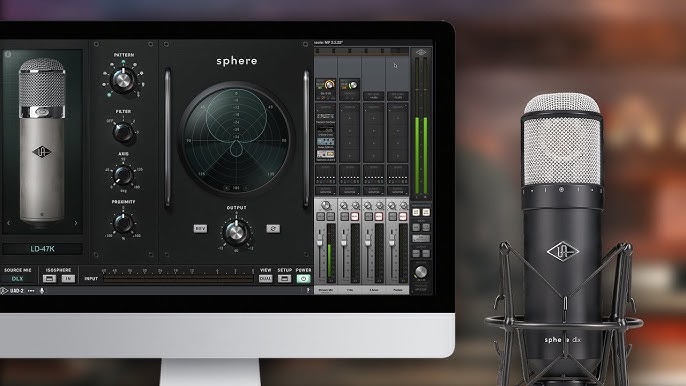
The Universal Audio Sphere LX is one of our top picks for hitting the sweet spot of price to value.
Buy it new on Sweetwater, B&H, Thomann, or Amazon. Look for deals on Reverb.
It’s also wise to remember that differences between two vintage microphones of the same model may be larger than the differences between UAD and other brands, when there even is a notable difference at all!
And, because we don’t have access to the specific original mics that each company modeled, we can only speculate as to which models are truly more accurate to the target mic.
On top of that, your preferences may vary from mine. What sounded slightly “less full” to me in one case may sound ever so slightly “clearer and more present” to your ears, and may be the better choice for you mix!
So, with sound quality being so close between brands, there have to be other distinguishing factors to look at. And two factors that Universal Audio absolutely nail are user experience and rock solid operation.
Far and away, the DSP accelerated version of the Sphere LX and DLX from Universal Audio have the richest and most jaw-dropping feature set on the software side of any options I explored.
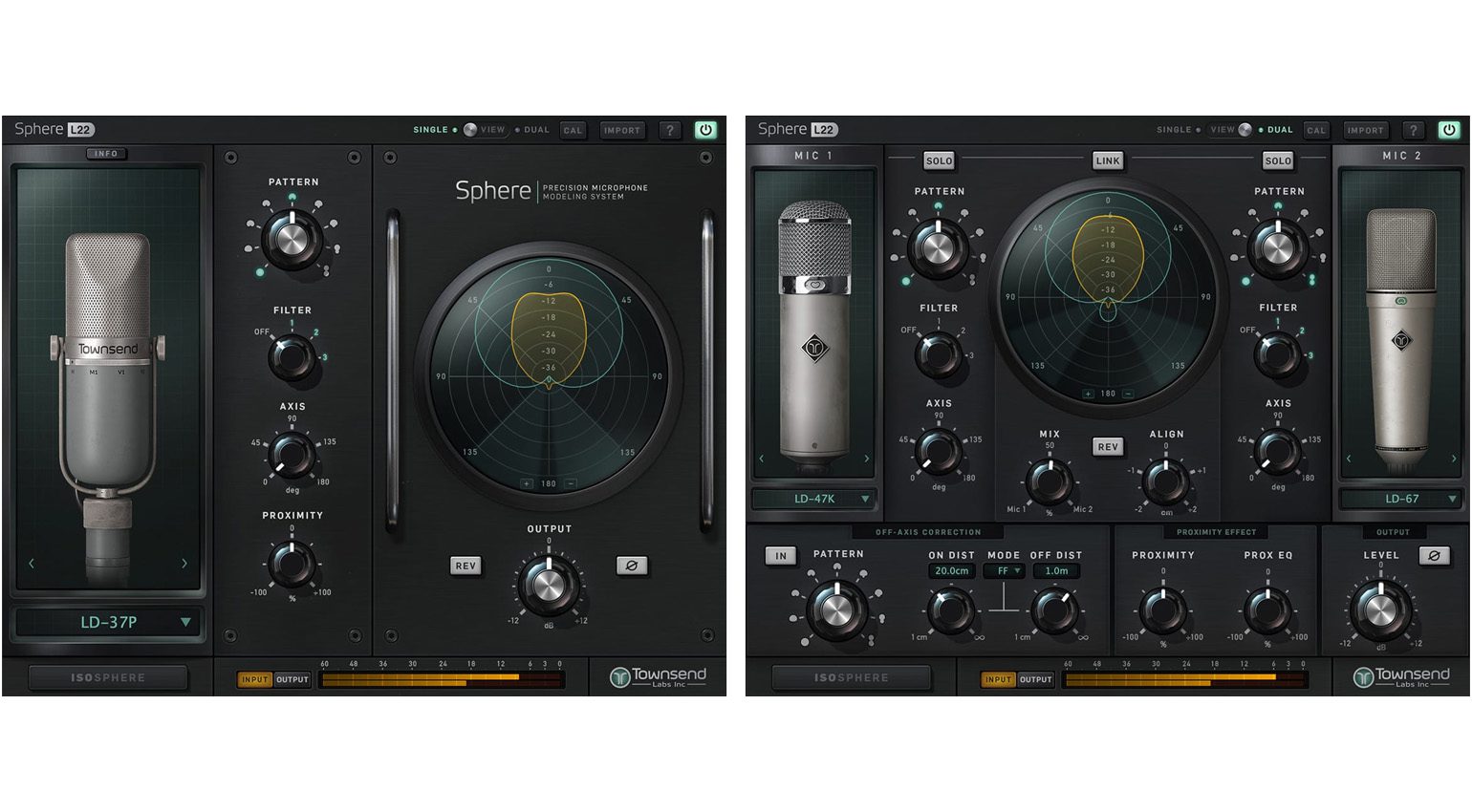
The Sphere software is the most fully-featured of any of the major brands.
Buy it new on Sweetwater, B&H, Thomann, or Amazon. Look for deals on Reverb.
The integration between the Sphere mics and the UAD interfaces and software is incredible, and they have some amazing features.
Especially notable are their multi-mic combination features, extensive presents from major producers, and even an acoustic filter correction module called “IsoSphere” that can be added after the fact.
IsoSphere adjusts the response for the off-axis coloration and frequency response changes created by foam mic accessories that are meant to block out excessive reflections in untreated spaces.
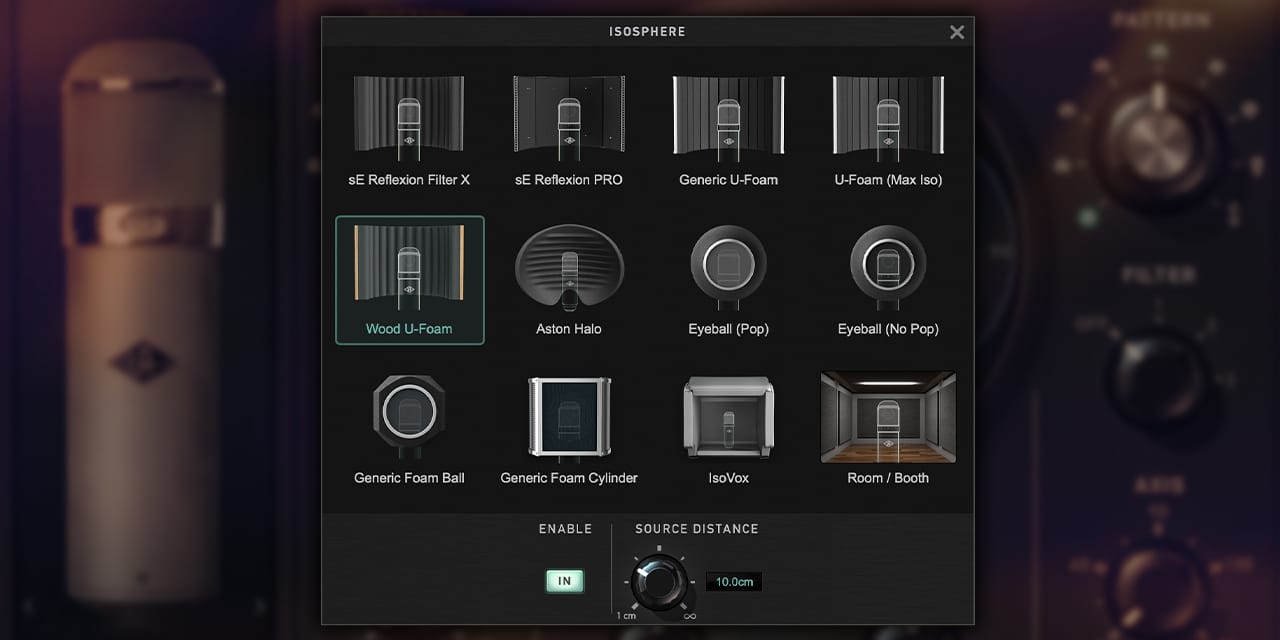
The “IsoSphere” features fixes the coloration caused by common acoustic filters often used on microphones in untreated spaces.
A full breakdown of all the features here deserves a full article in its own right, and I go into more depth in the video version of this article.
The Sphere series is the crowning achievement of the UAD modeling mics, with the more expensive Sphere DLX being more or less an exact reissue of the original Townsend Labs Sphere 22 at $1500. However, I believe that UAD have further improved on the software emulation from the original.
They’ve added on even more mics, and today, the ribbon and dynamic mics sound even closer to the target mics than I recall the very first Sphere mics being when I first tested them years ago. The transient response now feels more accurate when switching to the slower moving dynamic and ribbon models than I recall from my first tests almost a decade ago.
But basically just as good for $500 less is the Sphere LX. Compared to the Sphere DLX, the LX is slightly smaller at $999, with fewer switches, slightly different specs, and slightly fewer mic models included in the basic bundle.
But the smaller size of the LX is potentially a benefit to some users. It takes up less visual space which can be welcome on screen for video applications, or when reading sheet music or scripts, and due to the slightly smaller headbasket, the sound of the LX is minutely different to that of the DLX.
Listening to the LX next to the DLX, the smaller headbasket makes the LX sound slightly “tighter” and “drier”, while the larger headbasket on the DLX contributes to it sounding slightly more “open” and “airy” and “diffuse”.
Will this make or break a record? No. And there are some cases where the smaller headbasket can even help the LX sound closer to the target mic, such as with a Neumann U87 or 67, while the larger headbasket on the DLX can help it sound slightly closer to other target mics, like a U47, TLM 103 or M 49.
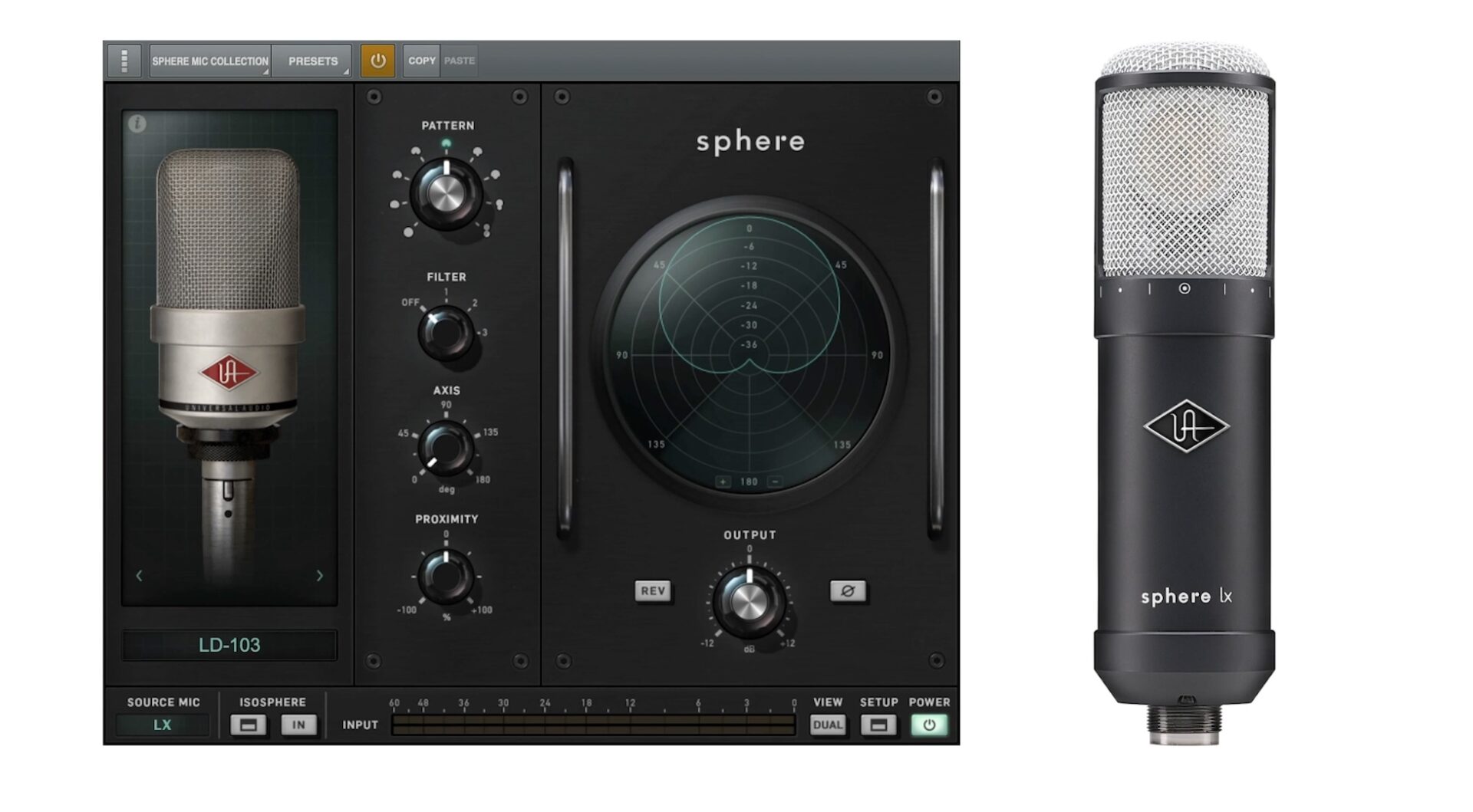
The Universal Audio Sphere LX
Buy it new on Sweetwater, B&H, Thomann, or Amazon. Look for deals on Reverb.
For $1499 the DLX is already a steal, but if you want to save a bit more, you aren’t missing out on much at all by going with newer LX for just $999. The only downside of both of these mics is that they require two inputs on your interface. They can be used with or without UAD hardware.
Below this is the new “Standard” series, which come in a slightly off white color and range in price from $399 for a large condenser, all the way down to $109 for a small dynamic.
The “Hemisphere” software included with this line software is less robust and full featured than the full-on Sphere suite and focuses on modeling dynamic and ribbon mics, with each model having a different suite of emulations.
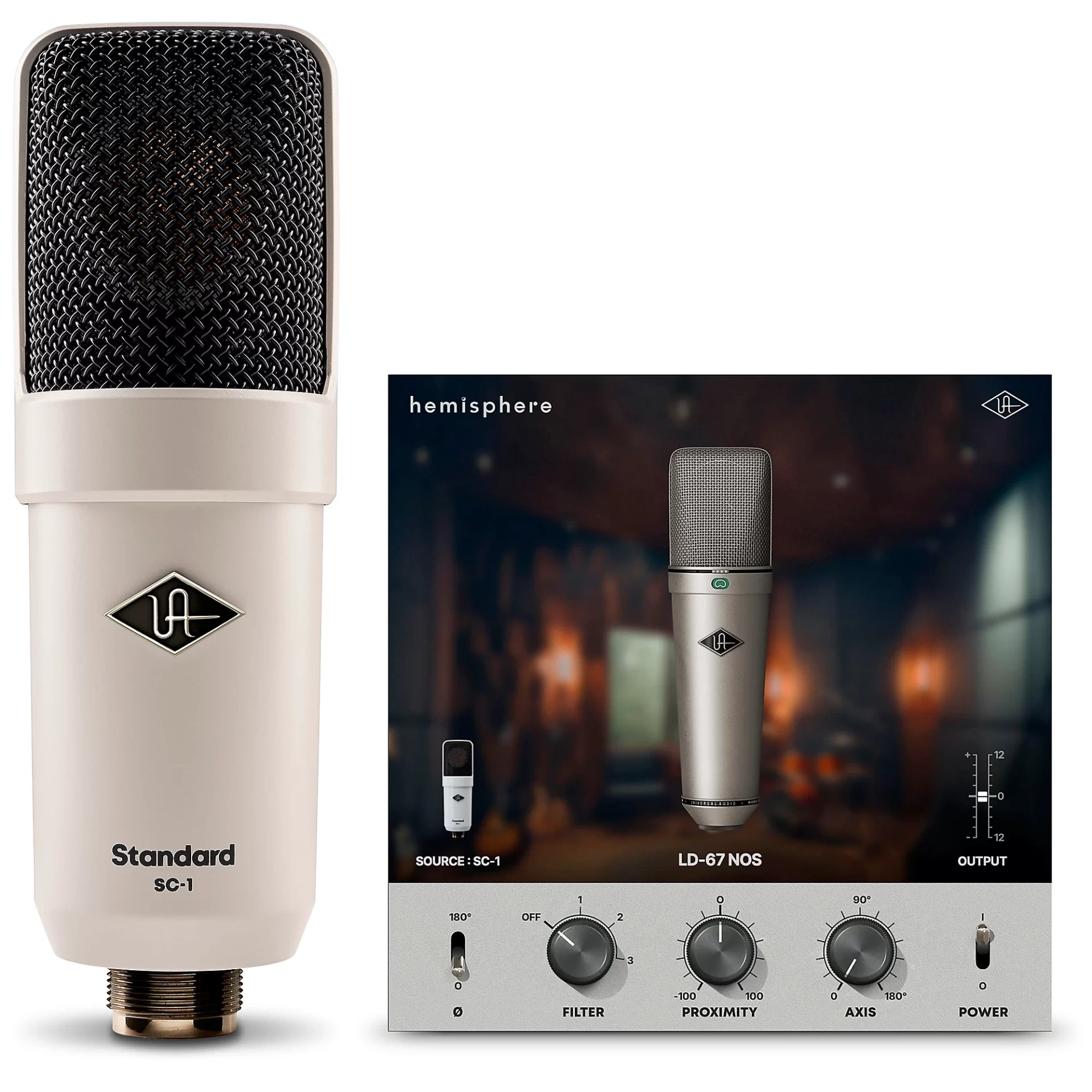
The UAD Standard SC-1 offers a single output large condenser for less than half the price of the less expensive Sphere mic.
Buy it new on Sweetwater, B&H, Thomann, or Amazon. Look for deals on Reverb.
The SD-1 for instance, emulates large dynamics like the Shure SM7B, Electrovoice RE-20 and Sennhesier 441, while the SD-5 emulates kick drum mics like the Shure Beta 52, AKG D12 and D112, the Audix D6 and Yamaha Sub Kick.
The SD-7 emulates mid-sized dynamics like the AKG 421 and some ribbons, while the SD-3 emulates smaller dynamics like the SM57 and Sennheiser 409, with some crossover between all models.
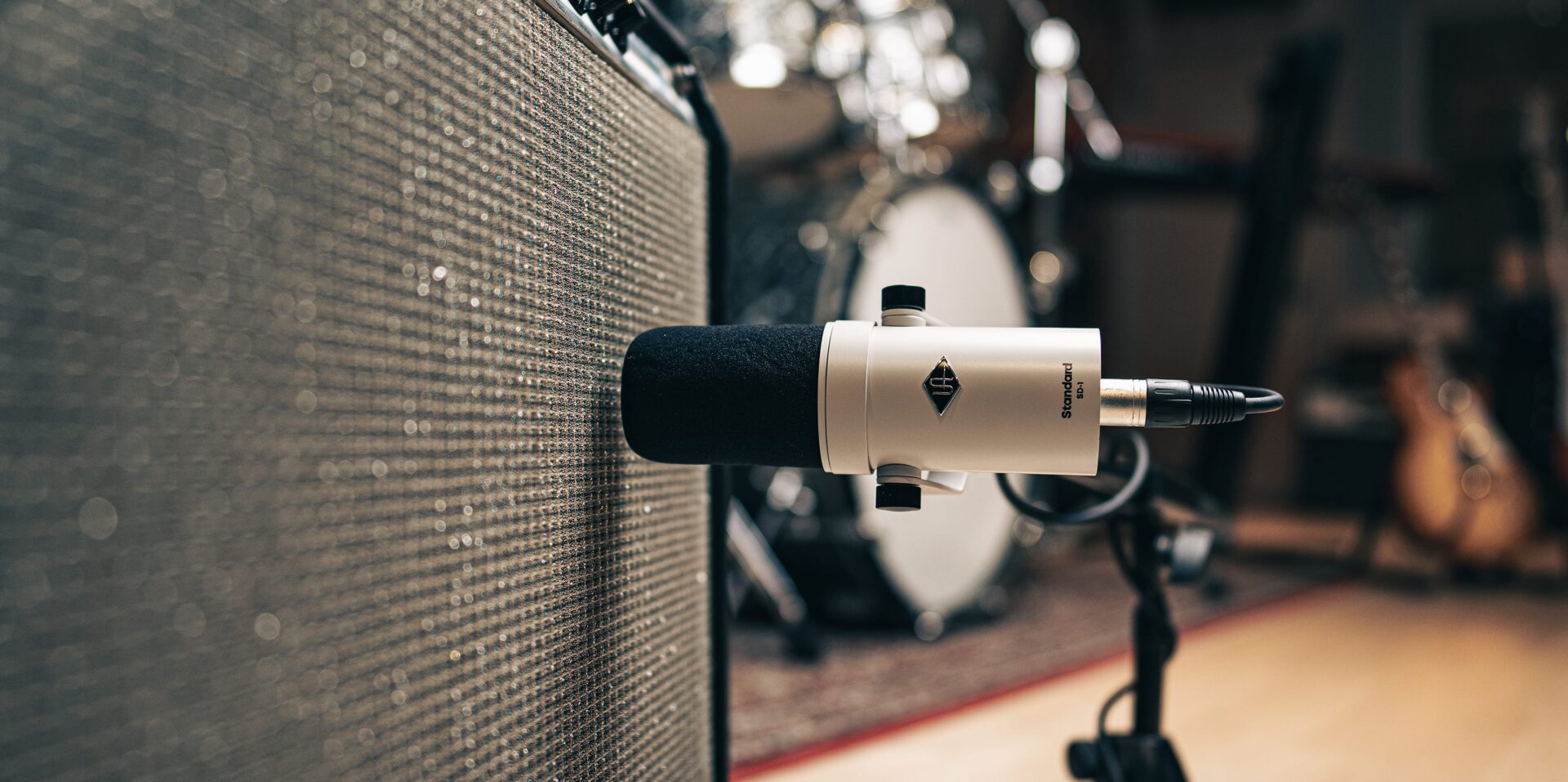
The Universal Audio SD-1 Large Dynamic Modeling Mic
Buy it new on Sweetwater, B&H, Thomann, or Amazon. Look for deals on Reverb.
It is entirely reasonable to think of equipping a full studio with just these modeling mics, and probably saving money while having sound quality and flexibility that’s basically on par with the mic lockers at any major studio.
20 years ago, I dreamed that a system like this would exist one day. And now it’s here.
(The only part that’s missing from my dream is that all of these mics would work on high quality wireless, and be the size of little electret condensers so I’d never have to plug things in and would barely even need mic stands…. so if any developers are reading, take note! 🙂
While I’m not certain I’d be ready to take the plunge to an all digital mic format just yet, I wouldn’t fault anyone for doing it. I might just be too old fashioned for now… But I definitely would love to keep at least one modeling mic in my studio.
Antelope Audio—Winner: Best All-In One Modeling Mics; Best Stereo Modeling Mics
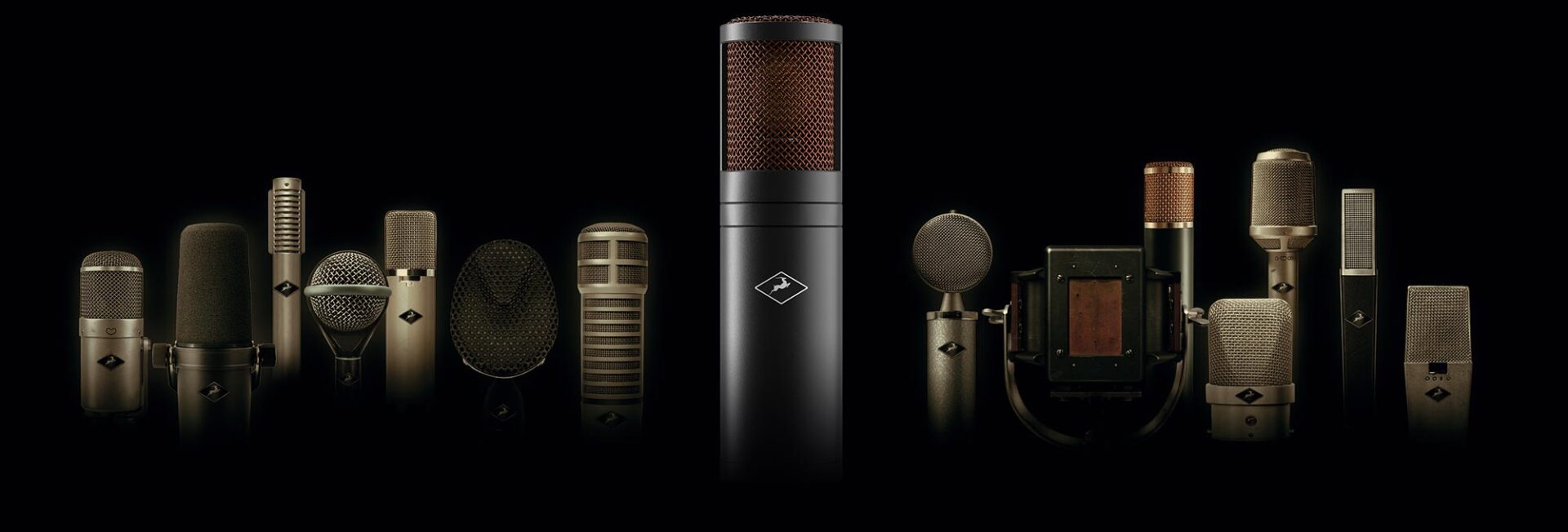
The Antelope Edge Series
Buy it new on Sweetwater, B&H, Thomann, or Amazon. Look for deals on Reverb.
Top Picks:
Axino Synergy Core USB Modeling Mic: $399 (On sale, reduced to $239 or less!)
Edge Go USB Modeling Mic: $1399
Edge Quadro Stereo Modeling Mic: $2,499-$2,999
Other Options:
Edge Duo: $1049
Edge Solo: $699 (On sale, reduced to $485!)
Edge Note $129 single, $249 pair
Just a couple of years ago, Antelope Audio might have easily beaten Universal Audio in the category of “Best Value” when it comes to modeling mics.
With mics and interfaces alike, Antelope has a knack for seeing what other companies are up to and offering just a little more in terms of features and specs for just a little less in price.
This was certainly the case with modeling mics, with the Edge Duo beating out the original Sphere modeling mics in price and (in some features)… right up until UA recently countered with the new smaller Sphere LX!
I wouldn’t be surprised if this only accelerates the modeling mic arms race however, and before long, Antelope may have its own counter to the Sphere LX that specs out just a little better, and is just as beautifully built, for just a little bit less money.
Antelope Audio’s Edge Duo costs $1049, and could have taken a lot of users away from Universal Audio when their only option was the Sphere DLX at $1499. But it now has stiff competition from the new Universal Audio Sphere LX at $999 which is a few dollars less and has even more robust software options.
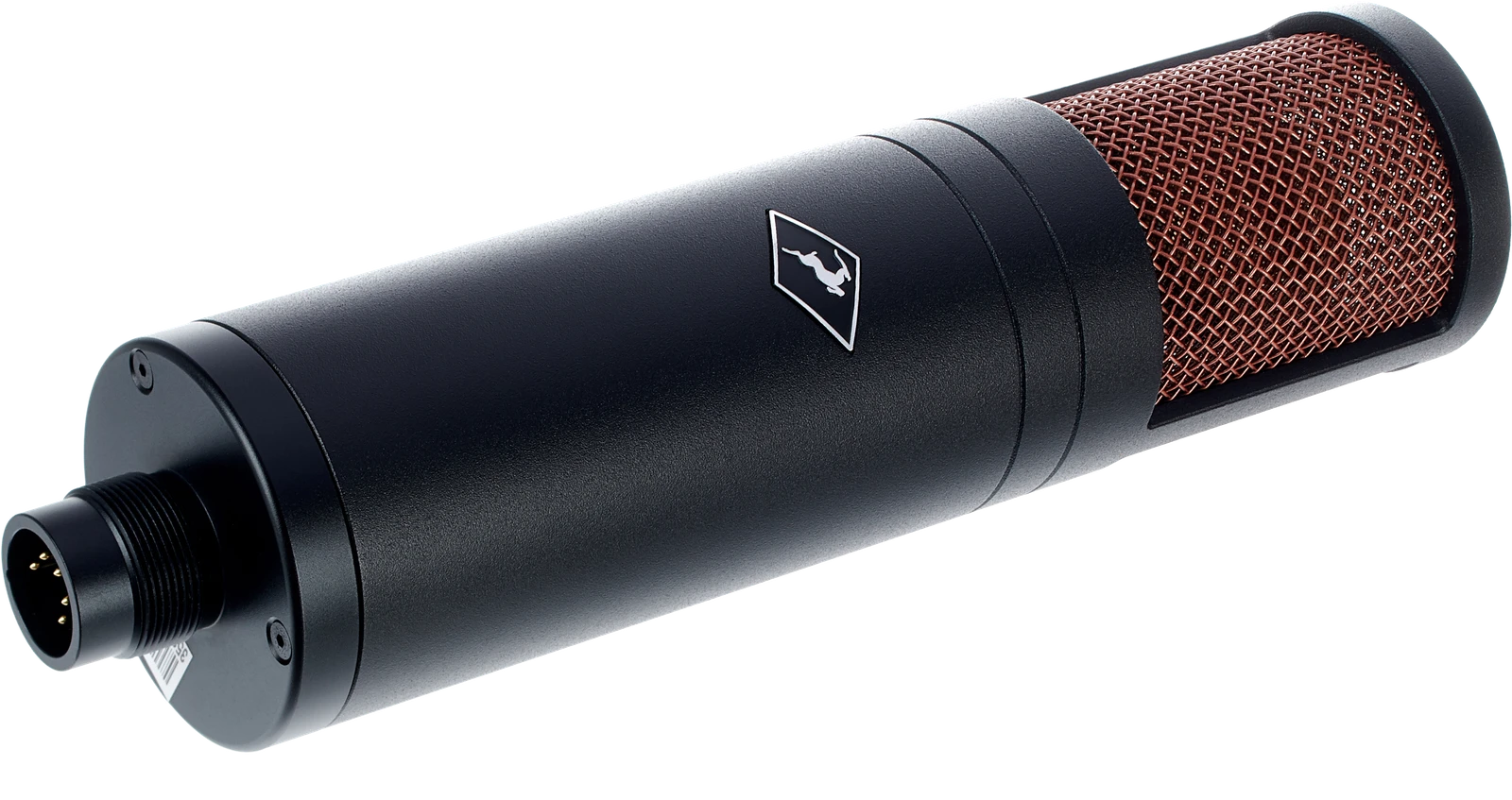
The Antelope Edge Duo was an obvious alternative to the original, higher priced Sphere mics before UAD added new less expensive models.
Buy it new on Sweetwater, B&H, Thomann, or Amazon. Look for deals on Reverb.
The same has happened for Antelope’s Edge Solo, which once handily beat out the Sphere in price, but is now being directly challenged by the new SC-1 from UAD.
Recently, UAD also added the SP-1 stereo pencil mics to answer Antelope’s super affordable Edge Note pencil mics, but here, once again coming closer to Antelope where they once were beaten by them. ($249 for Antelope vs $399 for UAD, on sale for $349.)
Until Antelope fire back with their next entry in the Edge series, aiming to one-up the Sphere LX , SC-1 and the SP-1, Antelope still wins out are in two other significant areas: All-In-One USB Modeling Mics, and Stereo Modeling Mics.
For the entry level user, the inexpensive Axino at $399 (which can be found at reduced price of $239 or lower at the moment) is an all USB modeling mic with built in DSP for recording at low latency, with effects. It acts as an additional interface, increasing your channel count… or can serve as the sole interface in your studio, complete with headphone output! It’s a tremendous value.
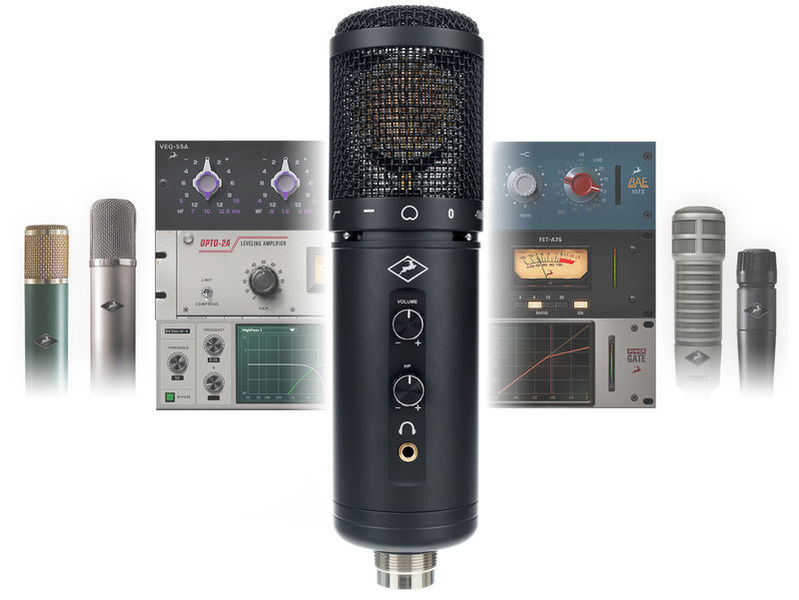
The Axino Synergy Core, all-in-one USB modeling mic
Buy it new on Sweetwater, B&H, Thomann, or Amazon. Look for deals on Reverb.
At the middle end, the Edge Go for $1395 is a two capsule modeling mic that, unlike the Sphere, doesn’t require you use up two channels of your interface. Why? Because the interface is built in! Like the Axino, you can plug right in via USB and take advantage of onboard DSP, all while adding channels to your interface, instead of taking them away, like with the Sphere or Edge Duo.
If you have a small interface setup and want to add high quality dual capsule modeling without losing channels, the Edge Go is THE way to go. This could be an ideal buy for studios that routinely record multiple channels or need to increase their channel count.
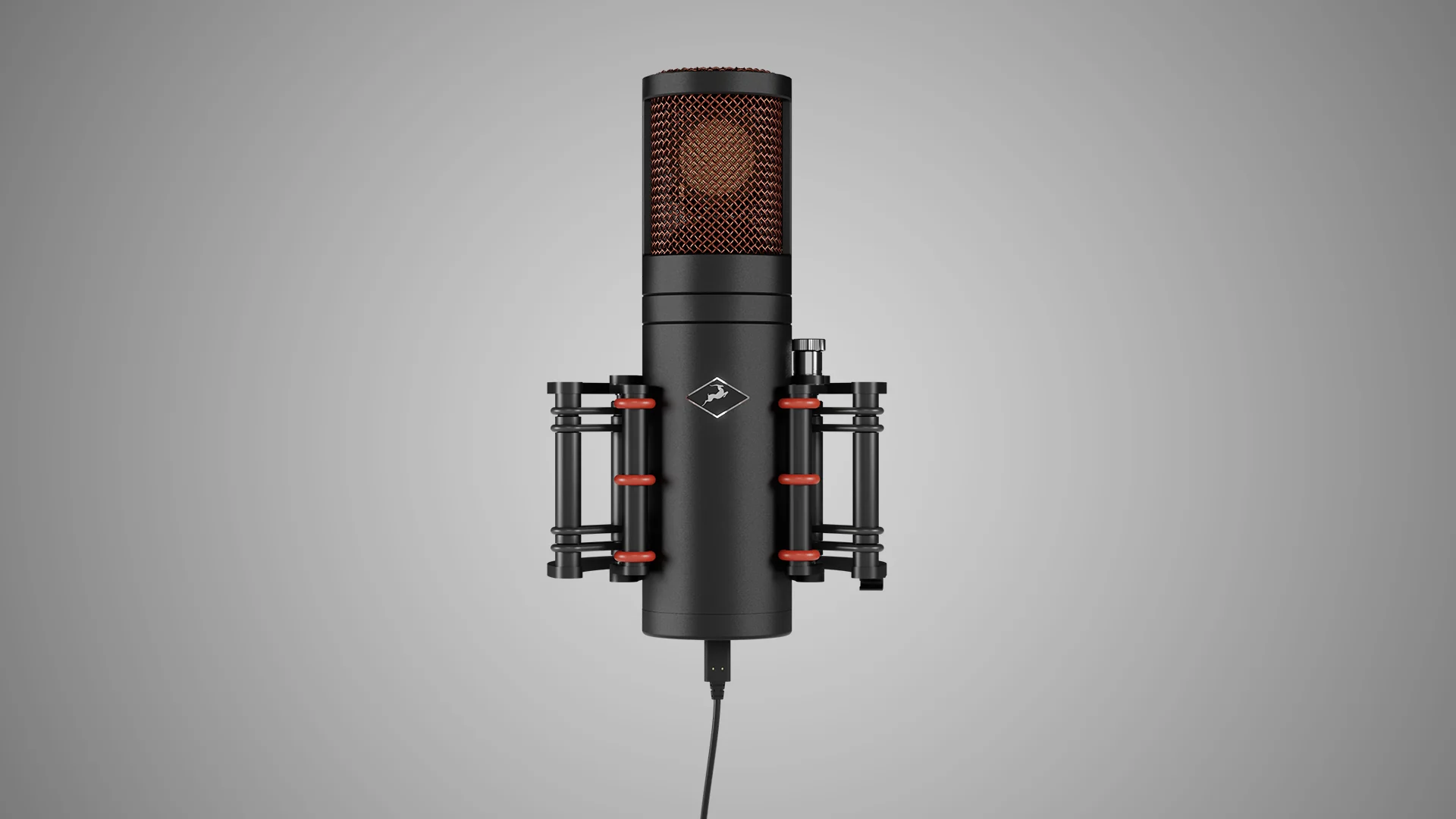
The Antelope Edge Go All-In-One USB Modeling Mic
Buy it new on Sweetwater, B&H, Thomann, or Amazon. Look for deals on Reverb.
For high end users, there’s the Edge Quadro starting at $2,495. This 4-capsule stereo modeling mic is a big improvement on the modest stereo capabilities of the Sphere DLX, and includes a rotating head for quickly changing the angle between the two dual-capsule mics.
With fully featured models of some of the best mics in history, this could be the only stereo mic a studio really needs.
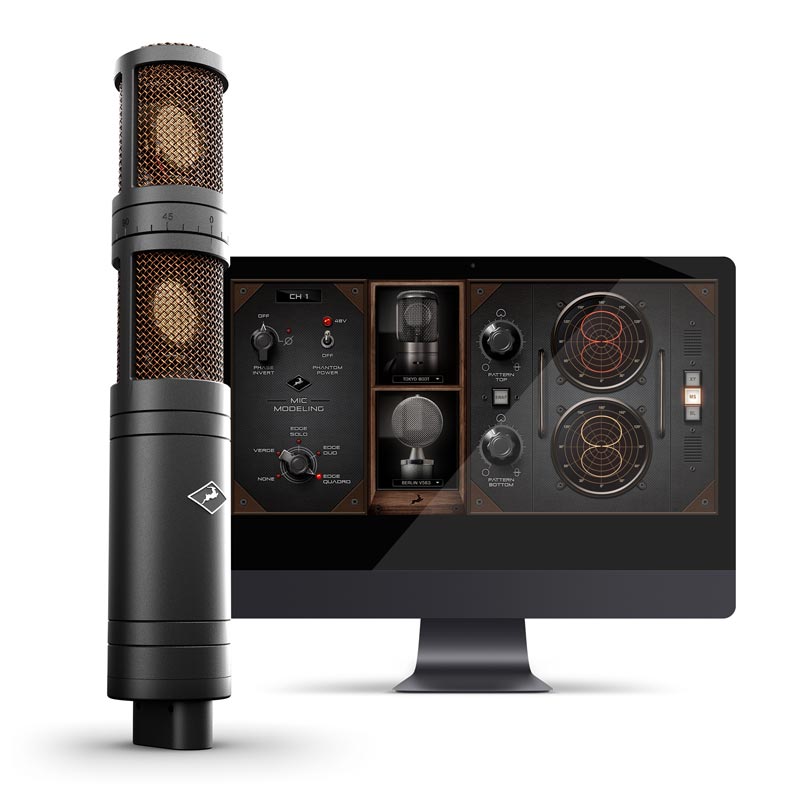
The Antelope Edge Quadro Stereo Modeling Mic
Buy it new on Sweetwater, B&H, Thomann, or Amazon. Look for deals on Reverb.
As for sound quality, in my subjective tests, I tended to prefer the Antelope Audio mics slightly over Slate Digital when there was a difference, and potentially preferred Universal Audio slightly over Antelope when I heard a difference… but this is hard to say with certainty.
For some users, the Antelope may win out in this regard, as its models generally have a bias that’s a bit of a “happy medium” between the slightly brighter tilt of Slate and the slightly fuller sounding tilt of UAD.
The only other “edge” (no pun intended) that I can give to UA is robustness of software. They UA Sphere does have more unique features than the AA Edge series, and if you are using their interfaces, the software reliability and integration of the UA systems is slightly better than Antelope’s.
While Antelope is still more than solid enough for professional use, in my experience and those of other commenters online, there are occasional glitches when first starting the system up that may require unplugging and replugging an interface or restarting an app or even the computer itself.
Fortunately, these startup issues are uncommon, easily remedied, and I’ve NEVER heard of them happening mid-session where there’s any risk of ruining a take. But the nod here goes to UAD for extra rock solid operation—though generally at a slightly higher cost for the same features.
UAD also deserves a slight nod for their very early integration of realtime DSP-accelerated effects inside your DAW, where Antelope originally only ran their DSP-accelerated effects outside the DAW, requiring extra routing. However, Antelope have recently patched this with their afx2daw software, and this is all becoming an increasingly moot point now that both companies have fully embraced native plugins as well.
Between the two brands, the vibe of Universal Audio feels a bit more like Mac computers, where there’s a great ecosystem in place that just works without you ever thinking about it, where Antelope strikes me a bit more like a high-end tricked out PC, where you usually spend less to get even more, and the brand often attracts those who are slightly more technically-minded.
Slate Digital—Runner Up: Best Value
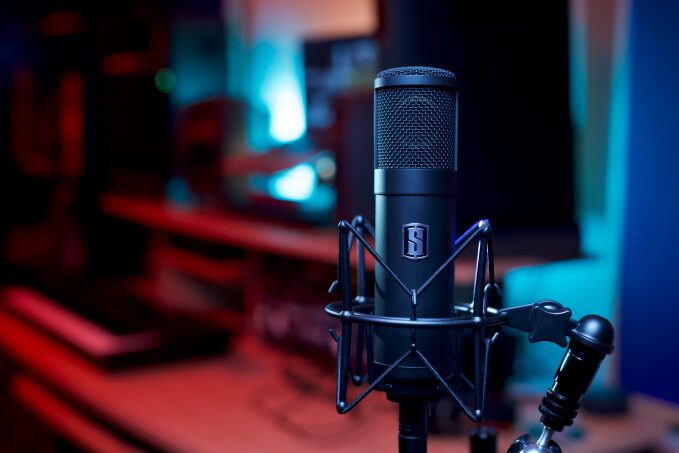
The Slate ML-1 Modeling Mic was first in class and still delivers great sounds.
Buy it new on Sweetwater, B&H, Thomann, or Amazon. Look for deals on Reverb.
Top Picks:
ML-1 Large Diaphragm Condenser: $599 and up
ML-2 Small Diaphragm Condenser: $149 and up
Slate Digital is the undisputed O.G. of high quality modeling mics, and their VSM system has been heard repeatedly on hit records since debuting in 2014.
Their original ML-1 large diaphragm condenser is still a great value at $599, with their complete system coming in at $999 with a preamp, hard case and shockmount. They even have an ML-2 pencil mic at $149 each.
These systems are still high quality and totally useful. But with UAD releasing the Sphere LX and Standard Series and Antelope coming out with the Edge Duo, Edge Go and Axino, it may be hard for Slate to keep up with the other two companies unless they cut prices or revamp the line.
That said, Slate also has some real potential advantages over Universal Audio and Antelope that may keep them from losing too much market share to the others right away.
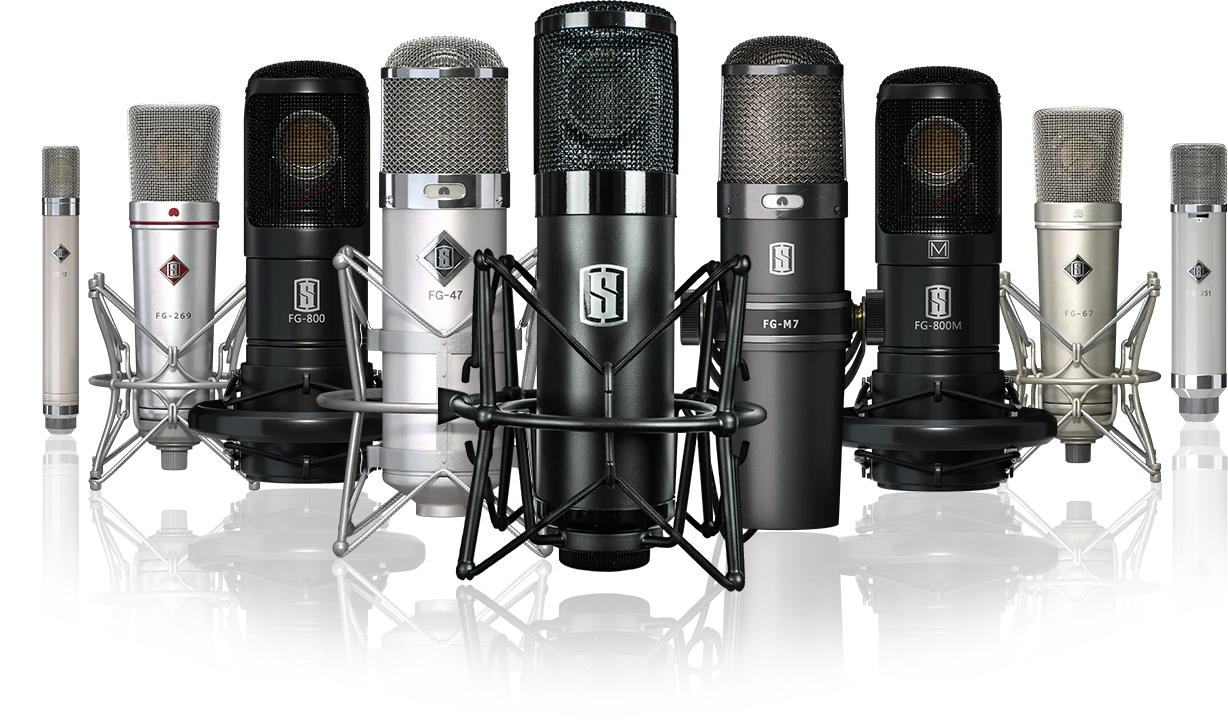
The ML-1 comes bundled with 8 mics in the Slate VSM system, with expansion packs available
Buy it new on Sweetwater, B&H, Thomann, or Amazon. Look for deals on Reverb.
The drawback of the Slate ML-1 compared to the Edge and the Sphere is that its single output necessarily makes the modeling slightly less accurate in modeling other mics than the Edge or Sphere series. Including dual outputs lets modeling mics more accurately model the actual polar patterns of the target mics, which is a surprisingly large component in getting the sound to be fully accurate to the original.
With that said, the single output ML-1 offers some real advantages as well. First off, it helps make the mic itself substantially more affordable than the other options, starting at just $599. The only modeling mics cheaper than that are the Axino (which does stack on additional features) and the new UAD Standard series.
And, perfect “accuracy” to the original isn’t the only thing that’s important. What matters is whether the mic sounds great in your studio, on your tracks—not necessarily how close it sounds to some vintage relic. The Slate models have their own tone, very very reminiscent of the originals, but often with slightly more modern, high end “sheen”.
The models might sometime sound more like a classic high end mic once some slight additional EQ has been applied to make it fit on modern recordings. If you like the slightly curated sound of the Slate over the others, it could win on that basis. (But again, these are relatively minor differences we are talking about here.)
The other benefit of single output modeling mics is that they take up just one channel instead of two in your interface. But once again, the Antelope Axino and Universal Audio Standard now solve this problem as well, and both at a lower price point.
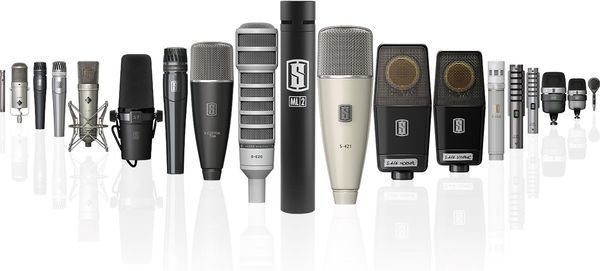
The Slate ML-2 Modeling Mic
Buy it new on Sweetwater, B&H, Thomann, or Amazon. Look for deals on Reverb.
Just a year or two ago, Slate would have been neck and neck with the other two brands as a top contender, but with UAD and Antelope continuing to upgrade offerings and cut prices, Slate may have to soon follow suit.
Maybe they have plans to upgrade at some point, because they were the only brand listed here than declined to send us review samples for comparison.
With all that in mind, the Slate is a super high quality option, and is more affordable than the top of the line options from UAD and Antelope. Can it keep up with the new lower cost options those brands have made available? Or will they be pushed to up their game once again? Time will tell!
Summing it Up
At the end of the day, ANY of the modeling mics listed here could be a perfect option for your studio.
From the low cost Antelope Axino and UAD Standard series, to the high end Sphere and Edge models, almost any recording studio could benefit from having one of this type of mic in their locker.
Even just as an educational tool, these mics can teach you about the rich history of our field and the wide array of sounds available. But on top of that, their track records show that they clearly won’t stop you from making records that are loved by many.
Justin Colletti is a mastering engineer and editor of SonicScoop. He is the creator of the Mixing Breakthroughs series of courses.
Please note: When you buy products through links on this page, we may earn an affiliate commission.







